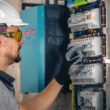Welcome to our comprehensive guide on the CuSO4 HCl reaction! In this article, we will delve into the fascinating world of chemical reactions involving copper sulfate (CuSO4) and hydrochloric acid (HCl). Whether you’re a student, a chemistry enthusiast, or simply curious about chemical processes, this article will provide you with a detailed understanding of the reaction between CuSO4 and HCl.
The Basics of CuSO4 and HCl
Copper sulfate, commonly known as CuSO4, is a chemical compound that contains copper, sulfur, and oxygen. It exists in various forms, including anhydrous CuSO4 and hydrated CuSO4 (with varying numbers of water molecules). On the other hand, hydrochloric acid, represented as HCl, is a strong acid composed of hydrogen and chlorine.
The CuSO4 HCl Reaction
The reaction between CuSO4 and HCl is a classic example of a double replacement reaction. When these two substances are combined, they exchange ions to form new compounds. The reaction can be represented as follows:
CuSO4 + 2HCl → CuCl2 + H2SO4
In this reaction, copper sulfate reacts with hydrochloric acid to produce copper chloride and sulfuric acid as the products. The balanced equation reflects the exchange of ions between the reactants, resulting in the formation of the new compounds.
Factors Affecting the Reaction
Several factors can influence the rate and outcome of the CuSO4 HCl reaction. These include the concentration of the reactants, temperature, and the presence of catalysts. Increasing the concentration of either CuSO4 or HCl can lead to a more rapid reaction, while temperature variations can also impact reaction kinetics.
Applications of the Reaction
The CuSO4 HCl reaction finds applications in various fields. One notable application is in laboratory settings, where it is used to produce copper chloride for further experiments. Additionally, this reaction’s principles are employed in industrial processes that involve metal extraction and purification.
Safety Precautions
It’s essential to exercise caution when working with both CuSO4 and HCl. These substances can be corrosive and harmful if not handled properly. Always wear appropriate protective gear, such as gloves and goggles, and conduct experiments in a well-ventilated area.
Frequently Asked Questions (FAQs)
Q: What is the purpose of the CuSO4 HCl reaction?
A: The reaction serves various purposes, including the production of copper chloride and the illustration of double replacement reactions in chemistry.
Q: Can I perform this reaction at home?
A: While the reaction is relatively simple, it involves working with potentially hazardous substances. It’s recommended to conduct such experiments under the guidance of a knowledgeable instructor or in a controlled environment.
Q: Are there any alternative reactions to produce copper chloride?
A: Yes, there are alternative methods to produce copper chloride. However, the CuSO4 HCl reaction remains a widely studied and practiced example in educational and industrial contexts.
Q: How can I ensure the reaction’s success in the laboratory?
A: To ensure a successful reaction, accurately measure the quantities of CuSO4 and HCl, maintain proper temperature conditions, and observe safety protocols.
Q: What are some additional resources to learn more about chemical reactions?
A: You can explore chemistry textbooks, online educational platforms, and academic websites to deepen your understanding of chemical reactions and related concepts.




